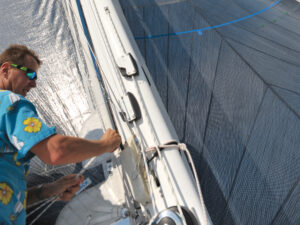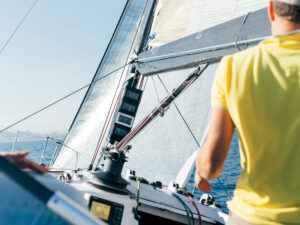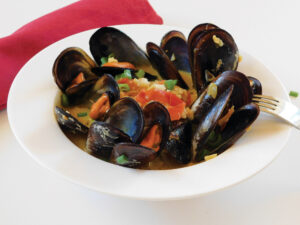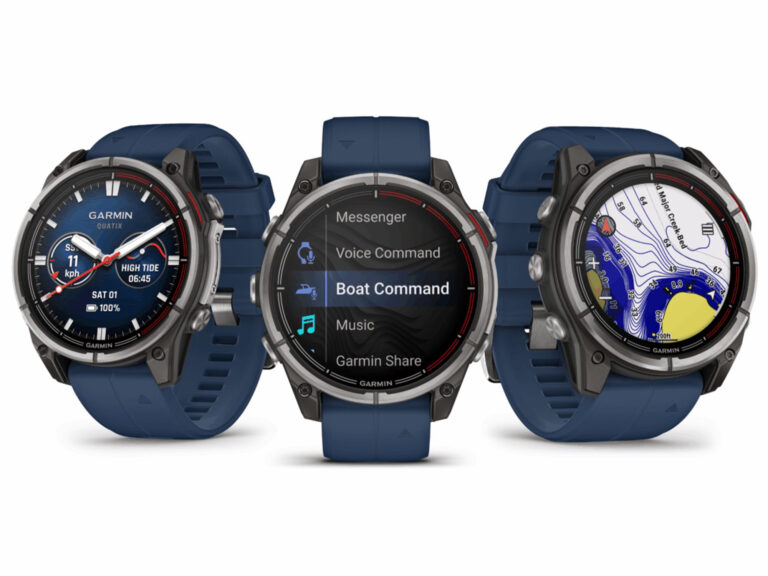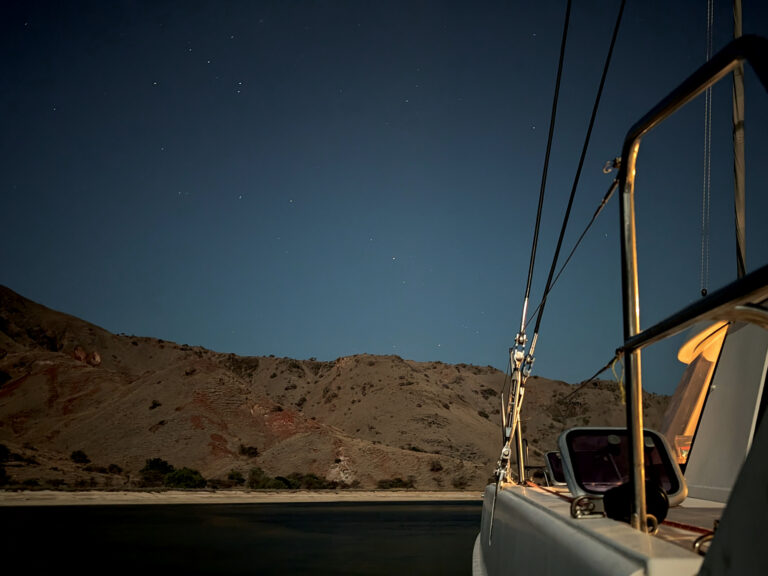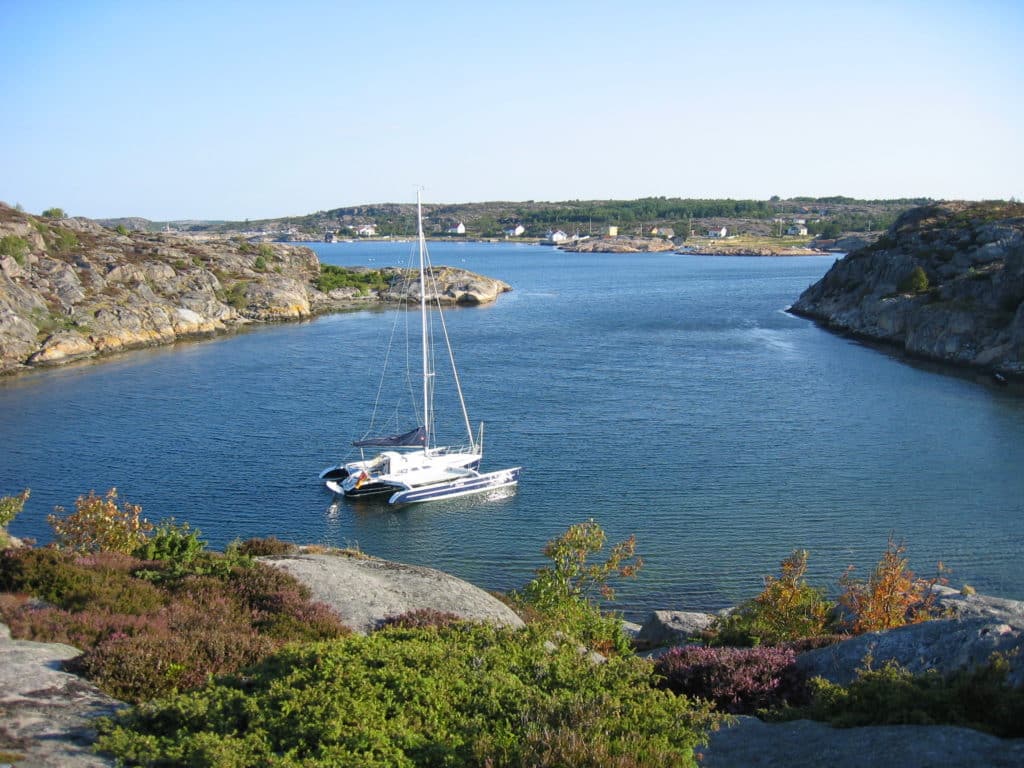
Single-handed multihuller, offshore pace-setter and Cruising World Boat Of The Year judge Peter Hogg said, “I like this boat. She’s a very good pocket cruiser, trailerable and nicely detailed.” Fellow panelist Bill Lee said, “This boat is fun to sail, with no real faults for her intended purpose.” And circumnavigator Mark Schrader said, “She’s a great pocket cruiser, one that sails really well and offers truly amazing accommodations for her size”. They were all talking about the new Borge Quorning-designed Dragonfly 920 Swing Wing trimaran.
Quality and refinement are not strangers to Denmark’s Quorning Boats where the 920 and three swing-wing siblings – the 1000, 800 and 600 – are built. Not too long ago the 33-foot Dragonfly 1000 took honors in the multihull categories of both Cruising World and Sailing WorldÕs 1994 Boat Of The Year competitions. At a little over 30 feet, the 920 offers virtually the same sailing package in a slightly smaller wrapper. The highlights: spry performance; safe, secure, on-the-level multihull cruising; wide beam easily reduced to ten feet for access to marinas and slips (and further reduced to 8’4″ for trailering); a kick-up centerboard; a kick-up rudder; and truly remarkable finished accommodations.
The newest Dragonfly mimics her predecessors with sandwich construction hand laid using polyester resin and PVC closed-cell foam core throughout the main hull, amas and deck. Each ama is divided by a pair of structural bulkheads designed to promote rigidity and create three separate watertight compartments, any one of which is said to have enough positive buoyancy to float the whole vessel (reassuring to say the least, though our scrutiny fell shy of putting that claim to the test). The main hull includes a crash bulkhead forward to contain collision spoil. The boat’s pivoting akas are fabricated of solid glass with unidirectional fabric oriented to optimize strength and rigidity; at the critical pivot points, stainless steel inserts spread the load and commit to a unified structural network once the whole operation is locked into place. The combination of finely tuned torsion cables, rigid aluminum locking struts and tensioned running backs ensures that the 920 when unfolded and secured in its sailing configuration has the overall integrity of a monocoque tri. Our sea trials aboard the boat supported this very notion; indeed, it felt solid and moved as one, a hardy trimaran unfettered by any apparent weaknesses in its various articulating limbs or points of attachment.
Deck, cockpit and rig are developed for convenient if not easy shorthanded sailing. The cockpit itself is smallish by wide-stern monohull standards, but virtually every control line you need to sail upwind, downwind or sideways runs back to it and remains at the helmspersonÕs fingertips. This includes adjustable jib lead pendants on the cabintop and some cleverly led runner tails that follow the after akas inboard and secure at rope clutches just outside the cockpit coaming. Standard are a pair of Andersen 28 self-tailing winches for halyards, reefing and other cabintop running rigging. A pair of Andersen 40 self-tailing winches serve primary duty on the cockpit coamings. The rig is a high-performance, two-spreader section of carbon fiber fully outfitted with Frederiksen gear, from the ballslide system at the luff of the full-batten mainsail to the two-speed block system and traveler running the mainsheet. The jib is on a furler and it pretty much owns the narrow foredeck; this relegates anchor deployment to an unobtrusive roller fitting on the starboard aka inboard.
The Dragonfly people have been complimented before on the success of their cabinetwork and interior execution and they deserve it yet again. Despite the obvious space constraints of a sleek 30-foot tri, they have managed to work wonders in the main hull of this one. All the elements are there: private sleeping quarters in the V-berth forward, a fully enclosed head, a working galley efficiency with its own dedicated sink and space for an optional alcohol or kerosene stove, a cozy saloon with longitudinal settees port and starboard flanking a fold-up dinette, and even a sizable hanging locker. The look incorporates satin-finished mahogany, white ceilings and upholstered seats.
There is standing headroom in the main cabin and ambient light by way of fixed glass windows. Twelve-volt electrical distribution is handled through a fused panel; two batteries offer a total of 144 amp-hours of DC power, while an AC shorepower package is available optionally. Provisioning and storage are addressed in a variety of bins, cubbies, lockers and nooks.
Sailing the 920 is effortless and fun. It’s a very quick boat but it’s also very stable, two qualities that combine to take the trepidation out of performance and allow an active family to indulge itself without feeling overwhelmed by the machine. In our light-air testing we churned along to weather aided by good sails and a sizable centerboard; off the wind we accelerated in total control, set a rather large asymmetrical kite, jibed it neatly from one windward ama to the next, and reveled in the boat’s speed and spunk. In the true spirit of lightweight, powered-up trimarans, this one moves out and stays on her feet – really a trip to sail.
And you reap huge dividends in versatility when the sails come down and it’s time to take her home. With the turn of a cockpit winch, the amas nest against the main hull in a matter of minutes, turning 22 feet of sailing beam into a marina-friendly 10 feet. A 9.9-horsepower four-stroke Yamaha outboard deploys off a bracket on the stern and powers the light craft away at six-plus knots. Shipped draft at 1’6″ gets you close to shore. Should you want to hit the highways, with a little more effort you can disassemble the boat and put her on a trailer with a road-legal 8’4″ beam.
In the end what you’ve got is a nifty little cruiser with good jets, shallow draft and complete albeit diminutive accommodations. The options list is extensive and worth studying: Everything from lifelines to a holding tank is apt to require your signature. When you come right down to it, however, Dragonfly trimarans in this country are treated on what amounts to a custom basis in the first place, which means that you specify yours to suit your needs for a few extra dollars. You’re not looking at a big old Swan that’s going to take you around the southern capes, but in the world of small boats and spiffy performance cruisers capable of bona fide cruising, the Dragonfly 920 is a real find. A day on the bay and you’re hooked.
Dragonfly 920 Swing-Wing Specifications
- LOA: 30’3″ (9.2 m.)
- LWL: 28’6″ (8.5 m.)
- Beam (max): 21’11” (6.68 m.)
- Beam (folded): 10’0″ (3.0 m.)
- Beam (trailered): 8’4″ (2.5 m.)
- Draft (c’bd dn): 4’10” (1.5 m.)
- Draft (c’bd up): 1’5″ (0.43 m.)
- Disp: 3,968 lbs. (1,800 kgs.)
- Sail area: 581 sq.ft. (54 sq.m.)
- Mast above water: 47’6″ (14.5 m.)
- Disp/Length: 77
- SA/Disp: 37
- Fuel: 7 gal. (27 ltr.)
- Water: 18.5 gal. (70 ltr.)
- Holding: 16 gal. (60 ltr.)
- Auxiliary: 9.9-hp outboard 4-stroke gas
- Designer: Borge Quorning
- Base price: $107,000
Dragonfly Sailboats Inc.
69 Hamilton Avenue
Oyster Bay, NY 11771
Phone (516) 624-8405
Fax (516) 624-8009

